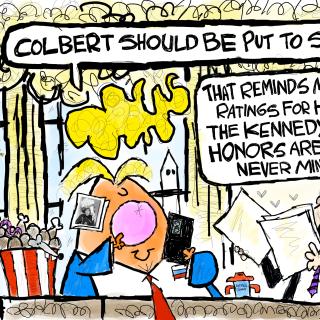The Manson tribe was not the only wolfpack of murderous maniacs to inhabit a remote ranch in L.A. County in order to foment a helter-skelter race war in America. Before the U.S.A. entered World War II, Nazi sympathizers endeavored to create a Hitlerian enclave at Murphy Ranch in Rustic Canyon, according to the new drama Blueprint for Paradise. Members of the Silver Shirts - a pro-Nazi organization with militia-like aspects - were suspected of drilling and training at this 50 acre compound near Pacific Palisades. Perhaps even more mindboggling is that in their effort to build this dystopia dedicated to the eugenicist “ideals” of the blonde-haired, blue-eyed Aryan super race, an African American architect was hired to render the eponymous blueprints for the goosesteppers.
In this riveting world premiere written by Laurel Wetzork the
playwright creatively uses artistic license to expand upon the sketchy historical record to imaginatively build a what-if plot that combines fact and fiction. Herbert Taylor (David Jahn) and his uneducated but well-to-do wife (who earned her money the old fashioned way - she inherited it) Clara Taylor (long suffering Meredith Thomas) are the L.A.-based moneybags collaborating with the Third Reich’s emissary, Wolfgang Schreiber (a smarmy Peter McGlynn straight out of National Socialist central casting) and homegrown fascist Ludwig Gottschalk (Steve Marvel) in their fantastical scheme to build a mini-Berlin-on-the-Pacific. Serving the bourgeois Taylors at their well-appointed house perfectly designed by Gary Lee Reed are a Chinese maid, Fenny (endowed with humanity by Ann Hu), and Alessandro (Alex Best), apparently a sort of butler and chauffeur of Italian ancestry.
Regi Davis, who acted in the great 2015 anti-racist film McFarland, USA, depicts the real-life architect Paul Revere Williams, who designed outstanding edifices, including Saks Fifth Avenue in Beverly Hills, and the private homes of many celebs, such as Bert “Cowardly Lion” Lahr, Lucy and Desi, etc. - presumably sometimes in neighborhoods where racist residential covenants would have prevented this African American icon from living. The play explores why the proponents of the Aryan übermensch ideology hired a Black man.
In doing so, these fascists, of course, undercut their own fantasies of racial superiority: The educated, talented Williams was simply the best man for the job they could find to hire. The scheming Wolfgang may also have wanted to employ an African American as a sort of cover for the undercover activities of these fifth columnists.
But the interaction between Williams - who is unaware of the true purpose of the project he is helping to bring about - and Clara sparks the plot. At least as far back as the days of Susan B. Anthony and Frederick Douglass, the interrelationship between women’s liberation and Black emancipation has been important. Williams is portrayed as someone who walks a perilous tightrope in a society where apartheid was still practiced - along with lynching. Yet, his talents, erudition and accomplishments awaken yearnings inside of Clara - who is constantly taking books out of the library in an autodidactic effort to better herself - to rise above her role as the dutiful Aryan wife who blindly follows her husband.
The flawed character of Clara sheds light on pre-WWII rightwing America. Today, we generally consider “antiwar” activists to be leftwingers. However, between the two world wars, many of those opposed to American military intervention against Franco in Spain, Mussolini in Ethiopia and the Germans as the goosesteppers gobbled up most of Europe, etc., were rightwingers. Blueprint mentions by name the America Firsters (of which the flyer Charles Lindbergh was the most prominent), the Silver Shirts, Mothers of America and the especially odious Pasadena-based so-called Human Betterment Foundation, extremist ideologues who advocated sterilization for the “inferiors” among us.
(BTW, the best motion reference to Nazi sterilization practices is in Stanley Kramer’s great 1961 master race masterpiece, Judgment at Nuremberg, when Montgomery Clift as the Jewish laborer Rudolph Petersen takes the stand. The tribunal finally gives this victim of Nazism, literally, his day in court when Petersen denounces fascists for sterilizing him because his mother was allegedly “feebleminded.” One assumes that to play this heartbreaking scene the tortured Clift drew upon his own sexual angst. In any case, see if you can watch this tremendously moving denunciation of sterilization without shedding a tear:
https://www.youtube.com/watch?v=jNEfFmSnPTA.)
Of course, there were those on the Left who also opposed U.S. military intervention during this period, including pacifists, such as conscientious objector Lew Hill, founder of Pacifica Radio. And in the 1973 movie The Way We Were, if memory serves correctly, Barbra Streisand’s leftist character likewise opposed American embroilment in the European conflagration. On the other hand, many leftists were in the vanguard of militarily fighting fascism, and the Abraham Lincoln Brigade included many Marxists who volunteered to fight Franco and his German and Italian sponsors, along with various anarchists, socialists, democrats, Trotskyists and communists of various stripes, as George Orwell recounted in his unforgettable 1938 antifascist classic about the POUM (Workers' Party of Marxist Unification), et al, Homage to Catalonia.
In Los Angeles the Hollywood Anti-Nazi League, which raised money for ambulances for the Spanish Republic, etc., and other popular front organizations spearheaded the era’s resistance to fascism. But in Blueprint the Left is only derogatorily mentioned in passing by the pro-Hitler characters. The FBI was not the hero of America’s anti-Nazi movement, just like J. Edgar and his boys weren’t the good guys in the Civil Rights movement, contrary to the 1988 movie Mississippi Burning (which presumably had Medgar Evers turning in his grave). I’d love to see a documentary or play about HANL and Tinseltown’s other antifascists to set the record straight.
But Blueprint does have a real hero: Once Paul Revere Williams realizes what his subversive employers are really up to, he more or less proclaims - to paraphrase his revolutionary namesake - “the Germans are coming, the Germans are coming!”
The ensemble is deftly directed by Laura Steinroeder. In addition to being anti-racist Blueprint is another thing that was anathema to Nazis: Feminist. This two-acter is the first full length play produced by the Athena Cats, a collective of SoCal playwrights and directors dedicated to bringing “unrepresented works written by women to the stage.” Wetzork and Steinroeder both belong to this collective that is named after Athena, Greek goddess of wisdom, courage and the arts. Judging by how hard-hitting their first full-length project is, one’s thing’s for sure: These Cats aren’t pussyfooting around, and this reviewer eagerly anticipates their next production. (See: www.theathenacats.org/.)
Blueprinthas many references which contemporary auds may find to be topical, from radio reports about aerial bombing raids in Libya to strongman politics to the American proclivity towards fascism and so on. Overall, this is a very good play which mixes history with imagination. There has been lots of criticism recently about racism onscreen with the #OscarsSoWhite campaign and it’s interesting to see how this may be playing out onstage, too, especially in L.A. Just as the musical Recorded In Hollywood introduces theatergoers to the real life music impresario John Dolphin, Blueprint shines a spotlight on another important historical African American figure, Williams. And both plays, of course, condemn racism and are set in the City of the Angels.
One way to promote this play might be to organize a trip to the actual Murphy Ranch where the Reich’s would-be White House might have been built. Perhaps at the Rustic Canyon location a scene for the play could be staged, onsite. In any case, Wetzork and her creative collaborators have built a topnotch piece of anti-Nazi political theatre that deserves to be seen not only on the boards of the Hudson Mainstage, but far beyond. Tomorrow, the world!
Blueprint for Paradiseis being performed on Fridays and Saturdays at 8:00 p.m. and Sundays at 3:00 p.m. through Sept. 4 at the Hudson Mainstage Theatre, The Hudson Theatres, 6539 Santa Monica Blvd., Los Angeles, CA 90038, at Theatre Row. For tickets: Call (323)960-4412 or see www.blueprintforparadise.com.
L.A.-based reviewer Ed Rampell is the co-author/author of four film history books, including “The Hawaii Movie and Television Book” (http://hawaiimtvbook.weebly.com/).



